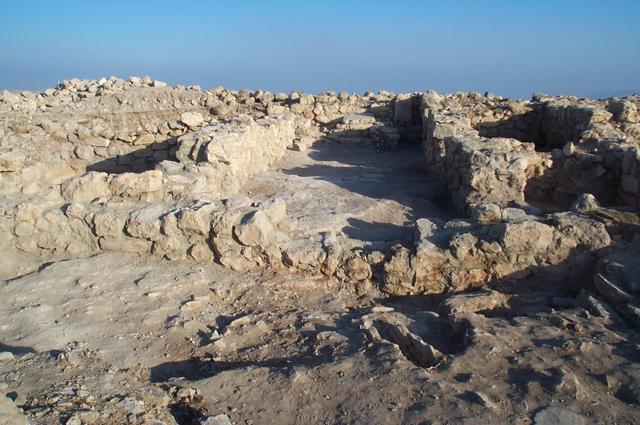
Khirbat Ataruz: Ancient Crossroad Of Religion, Trade In Jordan
During the Iron Age, it was a fortified town situated on an important crossroad that intersected on a ridge overlooking the Dead Sea. The ancient roads that led from the Dead Sea, the Wadi Sayl Haydan and the town of Madaba met at this important cultic site.
The American scholar Nelson Glueck (1900-1971) was the first Western researcher to document the region surrounding Khirbat 'Ataruz when he visited the East Bank in 1937. Glueck concluded from the numerous Iron Age I-II sherds that the site was initially occupied during the Iron Age but later abandoned until it was reoccupied during the Late Hellenistic period.
Additional sherds from the Late Hellenistic through the Middle Islamic period were also found suggesting a limited occupations during these periods as well. A later survey conducted by Schottroff found additional Iron Age settlements sites throughout the Jabal Hamidah region.
In 1983, Schottroff found an abundance of as Iron Age pottery as well as a figurine fragment that he believed was made sometime during 11th - 9th centuries BC. In the summer of 1998, Chang-Ho Ji and Lawrence T. Geraty surveyed Khirbat Ataruz as part of the Dhiban Plateau Survey Project.
They also found Iron Age sherds but the western and south-western portions of the site were being used as a modern cemetery for the local village of Jabal Hamida and were unsuitable for excavation.
However, the eastern side of the tall had several visible wall lines and some ruins above ground. A dry moat was found on the north and south sides and several limestone caves were also discovered. The first six seasons [2000-01, 2004, 2006, 2008, 2010] of excavation at Khirbat Ataruz has exposed many architectural and material remains, Robert Bates who worked as field archaeologist at the site.
In 2000, the archaeological team discovered a cultic structure with vessels and other artefacts related to a potential pagan temple.
The discoveries were fragments of two possible model shrines, sea shells, a pedestal bowl, a lamp and a bronze piece with Egyptianise duraeas and cobras, Bates continued, adding that subsequent excavations revealed a 4.1 x 11 metres temple oriented towards the rising sun with doorways that opened into adjacent rooms and a main doorway that opened into the central courtyard.
"The southern room contained a hearth and a platform/altar and the north room with three entrances may have served as a storage area. Additional buildings on the northern side contained a two raised bedlike platforms and stairs to another possible altar, Bates said.
"The eastern side doorway of the main temple building opens directly on to a large courtyard where there are several altars and another building. Four altars face an enclosure wall on the east and a large altar on the north side has a step. Abutting the eastern wall of the temple next to the doorway is a four-tiered stepped structure whose purpose remains unknown," Bates elaborated.
There are three phases of cultic activities at Khirbet Ataruz according to scholars. The activity is roughly dated from 10th BC until 8th BC.
At that time, the site was a major cultic centre that was probably built and maintained by national or at least regional political entity. The temple complex was well laid out, centrally located and built at the highest point of the site, Bates underlined, adding that in the Main Sanctuary next to the offering table, a standing stone represented the supreme deity.
"Further excavations suggest that a bull motif was also used to symbolise this god. The cultic objects found near the alter and in other parts of the temple complex reflect the same types of cultic material found at Tell Megiddo and Tell Dan in west of the Jordan River," Bates said, adding that during the Iron IIB-IIC periods, Khirbat 'Ataruz was rebuilt and reused.
Currently, there no evidence of either domestic or cultic activity taking place until the early Hellenistic period when it was rebuilt.
The Hellenistic occupants of the tell reused the earlier Iron II structures and added two long walls inside the Hearth and Double Platform Rooms, Bates elaborated, adding that also several walls and rooms in the south-western part were also built during the late Hellenistic and early Roman periods (ca. 200 BC-100AD).
During that period, Khirbet Ataruz the centre of cereal farming, wine and olive oil production.
"However, by the end of the 1st century CE, a decline agricultural prosperity together with increased political turmoil in the region contributed to the site's abandonment. Khirbat Ataruz remained unoccupied for nearly 800 years before it was resettled in the Middle Islamic period [ca. 1000-1400 AD]," Bates concluded.

Legal Disclaimer:
MENAFN provides the information “as is” without warranty of any kind. We do not accept any responsibility or liability for the accuracy, content, images, videos, licenses, completeness, legality, or reliability of the information contained in this article. If you have any complaints or copyright issues related to this article, kindly contact the provider above.
Most popular stories
Market Research

- Manuka Honey Market Report 2024, Industry Growth, Size, Share, Top Compan...
- Modular Kitchen Market 2024, Industry Growth, Share, Size, Key Players An...
- Acrylamide Production Cost Analysis Report: A Comprehensive Assessment Of...
- Fish Sauce Market 2024, Industry Trends, Growth, Demand And Analysis Repo...
- Australia Foreign Exchange Market Size, Growth, Industry Demand And Forec...
- Cold Pressed Oil Market Trends 2024, Leading Companies Share, Size And Fo...
- Pasta Sauce Market 2024, Industry Growth, Share, Size, Key Players Analys...





















Comments
No comment